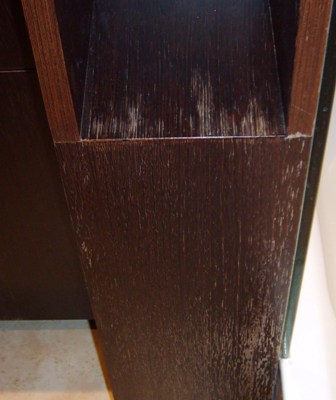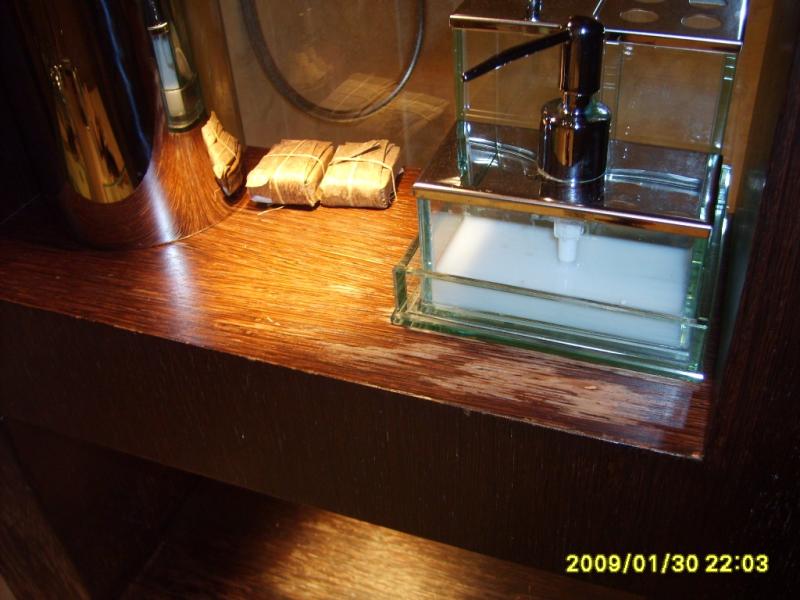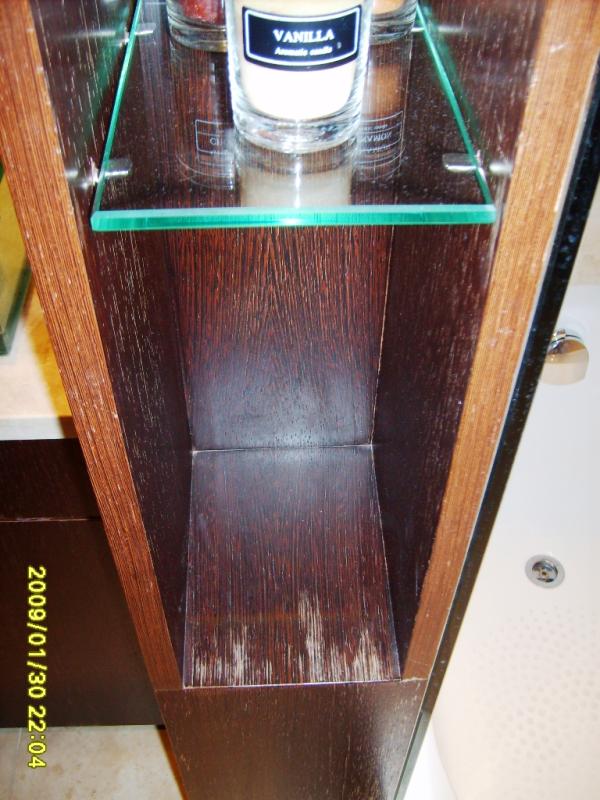Water Damage to a Bath Cabinet Finish
Finishers troubleshoot flaking and peeling lacquer on an MDF wood-veneer cabinet in a bathroom. May 13, 2009
Question
I did a bathroom tower unit which was made from veneered MDF. I did the finish with sealer and precat clear gloss lacquer, a year and a half after the customer called and said that the finish is flaking off. If anyone has come across similar problems please let me know.
Forum Responses
(Finishing Forum)
From contributor G:
What products were you using? Were they all from the same manufacturer (MLC, SW, Target, and etc? What types of stains, wipe on/wipe off, were there glazes involved? What was your painting schedule? Did you sand between all coats, did you go outside the manufacturers recoat window? We will need a lot more info to determine what the problem is/may be. A picture of flaking clearcoat will do little to determine the cause.
From the original questioner:
I've used the same manufacturer (Becker Acroma) precat sealer plus top coat clear precat gloss lacquer. It was sanded down between coats - no stain or glaze involved. Maybe I did too heavy on the top coat instead of two light ones?
From contributor G:
When you see it in person you have to look hard at it and see what is actually peeling. Is it the topcoat or the sealer? Does it go all the way down to the wood? On all my finishes I always use self sealing. I feel for the little bit of help you have with sanding provided by the sealer, there is always that chance of different products not adhering to each other. What does she use to clean it? So cleaners are pretty harsh. The same with disinfectants. Find out how she treats it and maybe that'll end up being the problem.
From the original questioner:
That well might be - the cleaning products. I never thought about this, so I will investigate further.
From contributor M:
What species of wood was veneered over the MDF?
From contributor E:
I would bet it is a moisture problem. It is probably flaking off the top edges of the doors and drawer fronts.
From contributor R:
I think contributor E might be on to something. No stain, no glaze, so I donít see an incompatible issue. Perhaps if the edges were not sufficiently eased or even rounded off, any kind of nick or dent on an edge will open up an area where moisture could seep into and swell the wood just enough to create the peeling problem. Iím not all that familiar with the products youíre using so forgive the ignorance. Did you use a vinyl sealer on the raw wood? If you sand the raw wood with too fine of a grit paper, your sealer coat sits on the surface of the wood instead of soaking into the wood.
From the original questioner:
The unit doesn't have doors. All the joints are mitered to lock into each other and it is made from Wenge veneered MDF. She said is flaking like clear skin of plastic. When I get to the workshop I will get exactly what it says on the drum of the sealer and lacquer. I'm based in U.K. so I guess some of the staff over here is different to the materials you are using in U.S.
From contributor U:
If you are based in the U.K., you should get some 2-pack (acid-catalyzed) lacquer. Precat is not very water or moisture resistant. Look for Morrells Woodfinishes on the web. Their stuff is excellent, they make a 2-pack specially for bathrooms.
From contributor U:
I forgot to say that you will have to remove the precat before you use the 2-pack. Morrells have a very good technical department if you need advice.
From the original questioner:
By getting rid of the precat do you mean sanding down with fine grit?
From contributor U:
Paint stripper will do the job. Make sure you clean down with thinners or stripwash after stripping. Wet the surface with cleaner and wipe off while it is still wet, then you can sand down. Apply a thin coat of dewaxed shellac before lacquering. This will seal in any grunge which might still lie on the surface. Three coats of lacquer should be ok.
From the original questioner:
Thanks contributor U. I think you are right with your diagnose - it is a water problem.

Click here for higher quality, full size image

Click here for higher quality, full size image

Click here for higher quality, full size image

Click here for higher quality, full size image
From the original questioner:
Contributor G you are right. The splash from the sink did all this. There is clear glass between the bath and the cabinet and that side is not damaged.
From contributor G:
Is that Becker finish water or solvent based?
From the original questioner:
Itís nitrocellulose precat based I believe.
From contributor G:
If it is nitro that is your problem, can't handle water and never should be in a bathroom environment. I don't think you can have a nitro precat. A precat should be able to take some water exposure. I have several vanities that I use MagnaMax precat on. It has some TR-4 specs but not fully compliant with them. I hope it doesn't work out to be too much of an issue for you.
From contributor J:
I've been using Magnamax since it came out and also have it on several bathroom vanities, including my own. I purposely leave water on it and after a few years it still looks great. I use it as a self sealer and apply three coats.
From contributor U:
I think Magnamax must be an American product, I've never heard of it. Get a good quality acid-catalyzed lacquer, that will be better than any precat.
From contributor U:
Water wash stripper is a lot weaker than solvent based, so it might not work very well. Also, when I tried water wash, I still had to use thinners to clean it off. I'd use solvent based stripper. Don't know anything about 2k poly, are you sure it's ok for bathrooms?
From the original questioner:
I've been told 2k poly is the best for bathroom. Thanks for the advice on the striper washer. I will get that on board. Out of subject but do you know if I could use solvent based exterior gloss over precat MDF primer. I did a sample piece and it looked ok but I don't know if it will age and crack quickly later on when left with customer.
From contributor U:
I've never tried using an exterior finish on top of a precat. As a general rule it's best to use compatible materials throughout. As you have already realized, sometimes a sample can look ok, but you might have trouble later when you scale up to the complete job. Whoever makes the gloss topcoat will make an appropriate basecoat if it is required. All good manufacturers have technical departments who will point you in the right direction.




